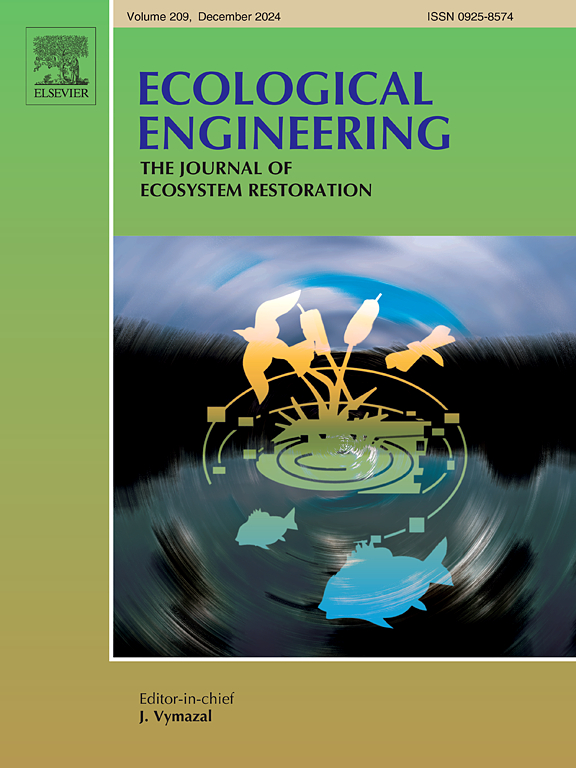转移危险:屏幕角度在鱼类撞击中的作用
IF 4.1
2区 环境科学与生态学
Q1 ECOLOGY
引用次数: 0
摘要
内陆水道的抽水有可能危害欧洲鳗鲡种群(安圭拉鳗鲡),如果它们没有得到正确的保护,可能会导致这种极度濒危物种的进一步减少。目前的指导方针旨在通过具体规定屏蔽类型、屏蔽孔径和最大接近屏蔽速度等缓解筛选技术,防止鳗鱼在进水口和出水口受到撞击和夹带。这些方法的目的是防止鳗鱼受伤,并让它们绕过抽象,但它们还没有经过实证检验。在本研究中,根据支持2009年鳗鱼(英格兰和威尔士)法规的现行环境局筛选指导文件,对具有3毫米孔径的水平和垂直楔形金属丝以及Hydrolox筛管进行了评估。我们测量了屏幕的流体动力学,然后观察了屏幕上游的鳗鱼行为和游泳动力学。筛管对上游流场的影响较小,并产生了适合鳗鱼擒纵的速度和湍流水平。在调节速度下,没有鳗鱼撞击筛管,验证了当前的导引效果,但在更高的速度下开始发生撞击,因此不应超过导引速度。与气流角度较小的筛管几乎不会造成鳗鱼撞击,因此更可取。目前3毫米楔形金属丝筛管的筛管指南适用于本研究中测试的尺寸的鳗鱼,不会造成撞击或夹带。本文章由计算机程序翻译,如有差异,请以英文原文为准。

Deflecting danger: The role of screen angles in fish impingement
Water abstractions in inland watercourses have the potential to harm European eel populations (Anguilla anguilla) if they are not correctly protected, potentially contributing to further declines of this critically endangered species. Current guidance aim to prevent eel impingement and entrainment at intakes and outfalls by specifying mitigation screening techniques such as screen types, screen apertures, and maximum approach velocities to the screens. These aim to prevent eels from being injured and allow them to bypass the abstraction, but they have yet to be empirically tested. In this study, screens with 3 mm apertures of horizontal and vertical wedge-wire and a Hydrolox screen were evaluated under the current Environment Agency's screening guidance document that supports the Eels (England and Wales) Regulations 2009. We measured the hydrodynamics of the screens and then observed eel behaviour and swimming dynamics upstream of the screens. The screens had minor effects on the upstream flow fields and produced suitable velocities and turbulence levels for eel escapement. At the regulation velocities, no eels impinged on the screens, validating the current guidance but impingement started to occur at higher velocities, so the guidance velocities should not be exceeded. Screens at smaller angles to the flow caused few eel impingements and therefore are preferable. The current screen guidance for 3 mm wedge-wire screens are appropriate for eels of the size tested in this study and do not cause impingement or entrainment.
求助全文
通过发布文献求助,成功后即可免费获取论文全文。
去求助
来源期刊

Ecological Engineering
环境科学-工程:环境
CiteScore
8.00
自引率
5.30%
发文量
293
审稿时长
57 days
期刊介绍:
Ecological engineering has been defined as the design of ecosystems for the mutual benefit of humans and nature. The journal is meant for ecologists who, because of their research interests or occupation, are involved in designing, monitoring, or restoring ecosystems, and can serve as a bridge between ecologists and engineers.
Specific topics covered in the journal include: habitat reconstruction; ecotechnology; synthetic ecology; bioengineering; restoration ecology; ecology conservation; ecosystem rehabilitation; stream and river restoration; reclamation ecology; non-renewable resource conservation. Descriptions of specific applications of ecological engineering are acceptable only when situated within context of adding novelty to current research and emphasizing ecosystem restoration. We do not accept purely descriptive reports on ecosystem structures (such as vegetation surveys), purely physical assessment of materials that can be used for ecological restoration, small-model studies carried out in the laboratory or greenhouse with artificial (waste)water or crop studies, or case studies on conventional wastewater treatment and eutrophication that do not offer an ecosystem restoration approach within the paper.
 求助内容:
求助内容: 应助结果提醒方式:
应助结果提醒方式:


